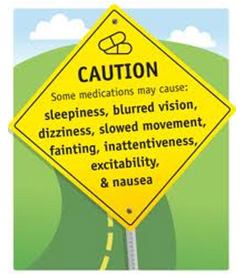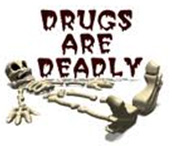 Both prescription and non-prescription drugs can alter your ability to drive safely.
Both prescription and non-prescription drugs can alter your ability to drive safely.
DO NOT operate a vehicle if using non-prescription (illegal) and even some prescription drugs!
Effects of Drugs on the Driving
You must never drive while under the influence of any illicit nonprescription drugs. The effects of illicit drugs on a person make the person incapable of safely operating a motor vehicle. It is a criminal offense to carry on your body or in your vehicle an illicit drug of any kind. Drugs kill. Drugs and driving do not mix.
First time use
The person should not drive a motor vehicle whenever using or trying a drug, prescribed or over-the-counter, for the first time. This is due to the unknown effects of the drug. It may cause the person to have symptoms that would make it unsafe for the person to operate a motor vehicle. Even when the person’s physician says that it should be safe to drive, it may not be the case in every person, since drugs have a different reaction on each person.
Do Not Mix Drugs and Alcohol
Do not mix two drugs together without consulting your physician and pharmacist. The two drugs may not be helpful when taken separately, but when mixed they could be deadly. The interaction of the two drugs could cause adverse effects on a person that makes the person unsafe to drive a motor vehicle. Remember that is it not advisable to drink alcohol while taking prescription or over the counter drugs.
Different Types of Drugs
Prescription Drugs
Even a mild prescription drug can cause you to lose your balance, concentration and responses. That is why it is important that a person who is taking any type of medication be aware of its side effects. Consult with your doctor or pharmacist about the medication that you are taking and its side effects.
Analgesics (Painkillers)
Pain-relieving drugs can be administered in the form of a tablet, injection or inhaled gas. The best-known analgesic is aspirin but many other compounds of varying strengths can be used. The strongest and most dangerous painkillers are derivatives of opium. The most effective and most addictive of these are codeine, morphine and heroin.
Antihistamines
Antihistamines may be given in the treatment of allergies and insect bites and stings. Because of their anti-emetic properties, antihistamines are also used in the control of nausea and vomiting. Unfortunately, they sometimes have a number of side effects and should only be taken on the advice of a doctor. Effects of antihistamines on driving are:
- Inattention
- Drowsiness
- Confusion
- Blurred vision
- Dizziness
Over-the-counter drugs (OTC)
OTC drugs are bought at a drugstore without a prescription. Many of these OTC, such as cough syrups, drops, sprays, pills and tablets for headaches, hay fever, colds, allergies, diet pills etc., can be dangerous when misused. Effects on driving are:
- Drowsiness
- Dizziness
- Slowed reaction
- Irritability
- Faulty judgment
- Blurred vision
- Impaired depth perception
Illegal Drugs
It is a violation of the law to purchase, use and or to have in possession. To mix these illegal substances with driving is also violation of the law.
Depressants
Depressants or Sedative-hypnotic drugs (SHD’s) include all tranquilizers, sleeping pills, anesthetics and antihistamines. Barbiturates, benzodiazepines and other sedative-hypnotic drugs are considered depressants of the central nervous system or “Downers.”
- Barbiturates are also called sleeping pills and use to bring a user down. The different forms of barbiturate’s cause many reactions on the body and mind. The drugs cause a person to sleep, relax and to get into an unconscious state. Taken as a relaxation drug, the drug takes away the user’s response time. It is unsafe for any person taking these drugs to perform the driving tasks safely and responsibly.
- Benzodiazepines cause sedation, slurred speech and dizziness in the user. It is a sedative that is mainly prescribe to patients under the physician’s care. Unfortunately, it is also available on the street in other forms as downers.
Stimulants
Stimulants are psychoactive drugs that induce temporary improvements in either mental or physical function or both. Examples of these kinds of effects may include enhanced alertness, wakefulness and locomotion. Due to their effects typically having an “up” quality to them, stimulants are also referred to as “uppers”
- Amphetamines and Methylphenidates can cloud the mind. They can cause dizziness, confusion, euphoria, increased motor and speech activity and drug-induced psychoses and hallucinations.
- Cocaine can have rapid access to the central nervous system and effects from “snorting” cocaine can be seen within 15 minutes. The effects of cocaine are similar to those of amphetamines with the exception that cocaine has the additional action of being a local anesthetic.
Narcotics
Narcotics analgesics are commonly referred to as opioids due to the action they have, which is the main active ingredient in opium. Opium is a derivative of the opium poppy, papaversomniferum. The most common adverse reactions or side effects of the narcotic are nausea, vomiting, dizziness, mental clouding and dysphoria.
Hallucinogens
Hallucinogens are drugs that put the user into a higher level on mental illusion, which they interpret as being real and visual. The user actually sees and feels things that are not there. They are dangerous to a user and all others on a roadway when the user mixes this drug with driving. Since the user has no real perception of what is real and what they believe is real, the users who drives may swerve to avoid a hallucination. The following are examples (but not limited to) of hallucinogens:
- Lysergic acid Diethylamide (LSD) or ecstasy is one of the most potent of drugs. Through research it seems that LSD appears to be rapidly and completely absorbed from the GI tract, due to the effects showing within 30 to 40 minutes after taken. LSD quickly crosses the blood brain barrier and psychic effects are seen soon after initiation of the drug.
- Psilocybin/Psilocin also known on the streets as the “sacred mushroom” or “magic mushroom.” Psilocybin or mushrooms are poisonous mushroom. Effects include increased heart rate, increased body temperature and dilated pupils. Psychic effects show an increased sensory perception and vivid visual imagery. The major difference between Psilocybin and LSD is that on a weight for weight basis, LSD is 150 to 200 times more potent. However, psilocybin can kill a person who ingests it, since it poisonous.
- Morning glory seeds/Ololiuqui cause the effects of euphoria, sedation, and hallucinations.
- DOM (2,5-dimethoxy-4-methyl-amphetamine) STP (Serenity, Tranquility and Peace). When orally taken, effects appear in approximately 1 to 1 and half hours and peak in 3 to 4 hours, subsiding after 5 to 6 hours. Physical effects are similar to those seen with LSD and include increased salivation and tearing as well as increased heart rate, blood pressure, respiration rate and pupillary dilation. Psychic effects are similar to LSD with vivid visual imagery and difficulty in controlling thoughts, expressions, and emotions.
- Belladonna Alkaloids derived from four plants in the nightshade family and have been associated with various religious rites as well as accidental and deliberate poisonings for hundreds of years. The active ingredients of these plants are atropine, scopolamine and hyoscyamine. Collectively these compounds are referred to as the “belladonna alkaloids.” Ingestion of any part of the plants or of the purified active ingredients will cause the production of a state, which is closer to delirium than the psychic alterations produced by LSD. The mental symptoms seem to fall into two basic patterns. The person will either be: (a) wildly delirious, disoriented, restless and irritable with loud hallucinations or (b) stuporous, confused, uncoordinated and unable to concentrate or respond appropriately.
- Phencyclidine (PCP) causes extreme disorientation, agitation and hallucinations. Deaths also occur with PCP abuse due to “behavioral toxicity.”
- Marijuana (Cannabis sativa plant) is the most widely used illicit drug in the world. Marijuana is commonly smoked in cigarette form, called a joint. The onset of action, when smoked is within minutes. Peak effects occur at 20 to 30 minutes, and the action ceases between 1 to 2 hours. Marijuana is very complex and marijuana does not fit into a class with any of the other psychoactive drugs. At low doses, marijuana has almost a stimulant effect with mild euphoria, increased sensory awareness and appreciation and alternations in time perception. With increasing doses, a sedative-like effect occurs characterized by impaired short-term memory, lapses of attention, disturbed thought patterns and passivity. With very high doses, there are changes in body image, depersonalization and marked sensory distortion, which are similar to effects seen with LSD and mescaline.
 Click Link for CA CVC for Driving Under the Influence of Alcohol and Drugs
Click Link for CA CVC for Driving Under the Influence of Alcohol and Drugs
Think Smart


